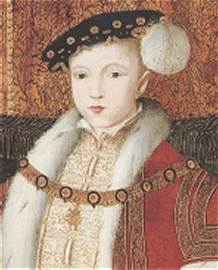

Edward
VI 1547 - 1553|
Born: Hampton Court Palace, 12 October 1537. |
|
Titles: King of England and duke of Cornwall. |
|
Crowned: Westminster Abbey, 20 February 1547. |
|
Ruled: 28 January 1547-6 July 1553. |
|
Married: |
|
Died: Greenwich Palace, 6 July 1553, aged 15. |
|
Buried: Westminster Abbey. |
A
s had happened so many times before, a strong and powerful king was followed by a weak one. Edward VI was the only surviving son of Henry VIII, and was only nine when his father died. His mother, Jane Seymour, had died giving birth, and though in his youth he seemed healthy, it became evident that he had a weak constitution. He had the potential to be a wise and powerful king, for he received an extensive education, and was raised with considerable care by his stepmother Katherine Parr. His childhood seemed to pass him by. Thrust into kingship and surrounded by scholarly men, Edward tried to run before he could walk, combining precocity with much of his father's stubbornness and self-centeredness.Edward's uncle, Edward Seymour, duke of Somerset, was made "Protector of the Realm" during Edward's minority and started the reign with an invasion of Scotland to enforce the marriage treaty between Edward and Mary, Queen of Scots. Although he defeated the Scots at Pinkie in September he was unable to break the Scots' resolve and in fact drove them closer to a marriage alliance with France. Edward was surrounded by rival factions who sought to control the king's mind when he was still too young fully to understand the motives for his actions. It seems that he genuinely regretted having to agree to the execution of Thomas Seymour, who had become his step-father, on grounds of high treason in March 1549, and in 1552 he also agreed to the execution of the protector, Somerset, who had presumed on his authority and been ousted from power in October 1549. In his wake the over ambitious John Dudley, earl of Warwick (and soon to be created duke of Northumberland) came to power, operating as protector in all but name.
Edward had been raised a Protestant and at the outset of his reign Protestant reform continued at an even greater pace than before due to the unremitting zeal of the Protector Somerset. All shrine and pictures of saints were destroyed, many processions were banned and the number of official ceremonies reduced. The first English Prayer Book was issued in 1548. There was much Catholic discontent throughout England, though the only manifestation of it was a rebellion in Devon in the summer of 1549 against the Common Prayer Book and this was promptly dealt with by Lord Russell. At the same time, in East Anglia, there was a repeat of the problems which had given rise to the Pilgrimage of Grace in 1536, when local peasants, under the leadership of Robert Kett, a tanner, rebelled against the enclosure of common land. Kett gathered together a force of ten thousand men to blockade Norwich, but the rebels were defeated by John Dudley and Kett was hanged.
Edward founded a number of grammar schools throughout England, which still bear his name, and he also established a workhouse for the poor at Bridewell and Christ's Hospital in London. It seems that the young king had a genuine concern to help the poor and needy as well as to promote education and learning. Although he was moulded into a zealous Protestant, he evidently promoted it with good intent. It was as much his concern as it was Northumberland's, that if he died young au the Protestant reform would be undone if his half-sister Mary, a staunch Catholic, came to the throne. He thus complied with Northumberland's plans in promoting Lady Jane Grey as his successor.
Edward's last year was one of much suffering. He contracted consumption and also suffered from congenital syphilis, passed on from his father. His death was a merciful blessing for him, but it would turn the country into a period of turmoil
By kind permission of "The Kings and Queens of England Website" (http://www.frhes.freeserve.co.uk/)